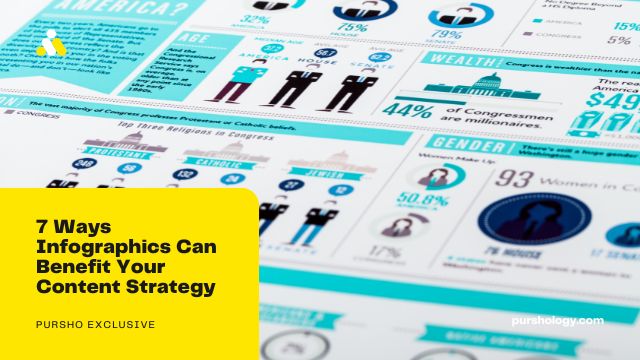Everyone knows that infographics are powerful tools to improve your content strategy. These items bring any writing to a new level because they enhance readers with precise information, raise the source’s trust, and boost metrics since people may devote more time to checking them and sharing them with others. Do you want to get extra motivation to make your content better using this simple yet mighty tool? This article considers the seven reasons infographics are so powerful. Keep on reading!
1. Infographics simplify everything
Infographics, visual representations of information, can easily convey complicated messages or concepts in an easy-to-understand manner. By breaking down complex subjects into simpler visuals, you can quickly communicate the key points to viewers without having to go through the trouble of writing lengthy paragraphs of text.
For example, if you’re writing about market trends or research findings, using visuals such as charts and graphs can help break down the data in an easy-to-follow manner. Thus, people understand it better.
Similarly, illustrative graphics or photographs can help illustrate points more effectively than words alone. Instead of just providing a wall of text, infographics give readers something exciting and visually appealing.
2. They are design solutions
Infographics are a great way to add style and design solutions to an otherwise bland website. Whether you possess an online store, a website, or social media account, infographics work for you. Not only do they add visual appeal, but they serve as a valuable source of information that improves content strategies.
How to create infographics easily?
It is also easy to add infographics; you do not need to hire an experienced designer to perform the task for you. Indeed, many marketplaces are collecting the best samples and templates free of charge, or at a price, so you can go there and take graphics for any taste and occasion. For example, MasterBundles provides infographics layouts for presentations, blog posts, SMM, newsletters, and literally anything. You can take and customize according to your current task providing readers with an engaging experience. Add value to your content with their powerful visuals.
What are the different styles?
Infographics design solutions come in a variety of styles and types. Standard techniques include flat, 3D, cartoonish, minimalistic, and retro-style graphics. Examples of infographics include data visualizations, flow charts and diagrams, timeline illustrations, and percentage comparisons.
Additionally, when designed correctly with a suitable color scheme and visuals, they can be visually appealing and readily shareable on social media platforms to reach a wider audience. By exploring various styles, artists can develop their unique techniques and stand out from the competition.
Delegate if you feel the necessity
The success or failure of an infographic depends heavily on the design quality; therefore, it may be vital to consult a professional infographics service that has experience in this area before creating your own. They already have some practices that work, so if you hesitate or have questions, they will be your helping hand. So, in a situation with less stress, you can use all the options yourself. With the right tools and resources, even a novice designer can create stunning infographics to help promote their brand.
3. Infographics showcase research findings
Infographics can benefit your content by making it easier to show off any research findings you may have. In addition, by converting research data into an easily digestible format, your viewers can take in the information at a glance and better understand your points.
How to select a matching style?
Various styles can showcase research through infographics, from simple bar charts or line graphs to more complex diagrams and illustrations. The chosen type should depend on the data presented and the information to include. Popular styles for presenting research include heat maps, flow charts, and timelines.
Different styles will work better for various research topics; for example, a chart or graph may be the best option if there is a lot of numerical data. On the other hand, an illustrated timeline or flowchart may work better if it’s a story-focused topic. Regardless of the chosen type, infographics are a great way to visually present research visually appealing and engagingly.
4. Communicate ideas with infographics
As an entertaining way to engage with content, infographics can increase your website’s visibility. Because they can be shared and embedded in external websites, using them as part of your content strategy can help you reach a wider audience. Additionally, because Infographics are eye-catching and contain valuable information, readers may be more likely to share them on their social media networks, thus increasing your online presence.
5. Draw readers’ attention
Infographics are also great for making cases more memorable and exciting. By creating engaging visuals highlighting issues or critical points, you can capture readers’ attention and draw them in with visually appealing content.
People are drawn to visuals that stand out from other text-based content; this is why infographics have become so popular on social media platforms such as Twitter and Instagram. In addition, infographics are shareable, which can help you drive traffic back to your website or blog posts!
6. Different audiences understand infographics.
By using infographics as part of your content strategy, you can ensure that all audiences understand the information presented. Communicate information appealingly and engagingly. From corporate leaders to students, everyone can benefit from using infographics to convey data and information more clearly and visually.
See the difference
For example, a corporate report might feature complex designs with multiple layers of information, while student reports may use simple styles like bubble charts or pictograms. Examples of popular types include flowcharts, timelines, bar graphs, and maps.
Additionally, you can use this type of media to break up long paragraphs into smaller components, which makes them easier to retain.
How to implement infographics in videos?
Video infographics offer viewers an easy way to understand complex topics and statistics. These visuals can make a video more engaging and easier to comprehend while assisting the viewer in quickly learning critical points or takeaways. However, when incorporating infographics into a video, it is essential to remember that the visuals must be easy to read and understand. Too much text or images can overwhelm viewers and confuse the point. If needed, use animations to help explain complicated topics.
7. Share ideas
Infographics are a great way to share ideas and emotions and convey your message. Give facts and statistics with a human touch by adding graphics that draw attention to the data presented.
How to start with infographics?
Before you design your infographic, you must do the research necessary to understand the topic you’re covering. Gather data, facts, and information that support your main point. Once you’ve gathered your content, it’s essential to structure the information in a way that makes sense and is easy to follow. Use visual cues such as headlines and icons to help guide readers through the infographic.
The possibilities are endless!
With the right set of design tools, templates, and resources, almost anyone can create effective infographics that will engage their audience. Plus, they’re easy to share on social media sites like Facebook and Twitter! So if you want to share your message with the world quickly – go ahead and make an infographic today!
Conclusion
You can make your content more effective and impactful by leveraging infographics in your content strategy. Whether you’re using these elements to present complex topics, showcase research findings, or highlight cases—infographics can help take your content strategy to the next level. Good luck in your endeavors!




